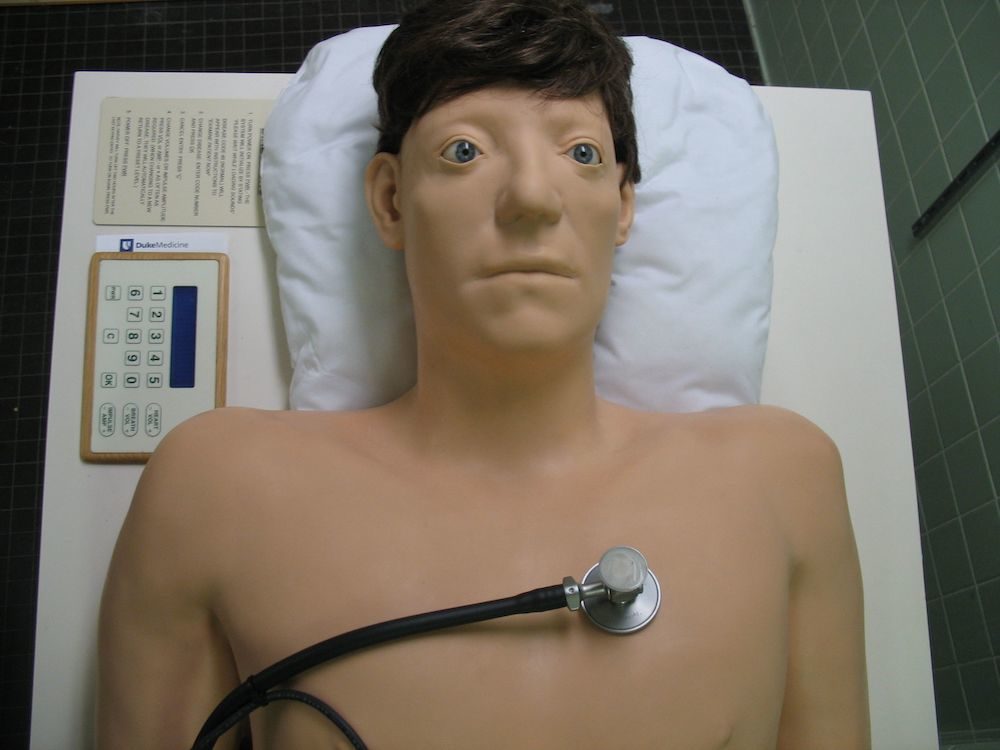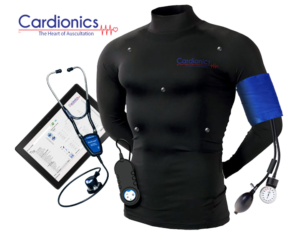Harvey Manikin Cardiopulmonary Simulator
The Harvey Manikin is a full-size Cardiopulmonary Simulator designed to simulate nearly any cardiac disease at the touch of a button developed by the University of Miami’s Gordon Center for Research and Medical Education (GCRME), which in the U.S. is distributed by Laerdal Medical. This is achieved by varying blood pressure, pulses, heart sounds, murmurs and breath sounds. For nearly 50 years, the Harvey Cardiopulmonary Auscultation Simulator has been used for university-based healthcare simulation projects across medical education and presents cardiac bedside findings with detail and fidelity.
Making this product such an effective learning tool, the Harvey Simulator provides a comprehensive cardiology curriculum by realistically simulating 50 patient scenarios. The structure of this curriculum entails beginning with common, less complex conditions and then progressing learners to more rare and complex diseases.
In the article, “A brief history of the development of mannequin simulators for clinical education and training,” by J.B. Cooper and V.R. Taqueti, they share that, “Harvey has been used for training medical and nursing students, interns, and residents, and for continuing educa- tion of family physicians.22 24–28 It has also been applied to testing bedside cardiovascular examination skills of medical students, residents, and attending physicians in internal medicine, paediatrics, and emergency settings. By providing a platform for standardised testing, Harvey was early in allowing for more comprehensive sampling of different skills.”
Sponsored Content:
Certain educational scenarios are available in both 60 and 90 beats per minute (bpm) with corresponding respiratory rate changes of 12 and 15 rpm, respectively. New features also include 20 additional patient scenarios – some with faster heart and respiratory rates – for a total of 50 conditions. These conditions include:
- Introductory Program
- Normal (60 and 90 BPM)
- Innocent Murmur (60 and 90 BPM)
- Aortic Valve Sclerosis
- Hypertension (60 and 90 BPM)
- Angina Pectoris
- Acute Inferior Myocardial Infarction
- Acute Anterior Myocardial Infarction
- Ventricular Aneurysm
- Mitral Valve Prolapse (MVP) (60 and 90 BPM)
- MVP, Isolated Click and Murmur
- Mitral Regurgitation, chronic
- Mitral Regurgitation, mild (60 and 90 BPM)
- Mitral Regurgitation, mild (variant)
- Mitral Regurgitation, acute
- Mitral Stenosis (MS) with severe Tricuspid Regurgitation (TR)
- MS with mild TR (60 and 90 BPM)
- Mitral Stenosis & Regurgitation
- Aortic Regurgitation, chronic (60 and 90 BPM)
- Aortic Regurgitation, acute
- Aortic Stenosis (60 and 90 BPM)
- Hypertrophic Obstructive Cardiomyopathy
- Cardiomyopathy (60 and 90 BPM)
- Acute Pericarditis (60 and 90 BPM)
- Primary Pulmonary Hypertension
- Atrial Septal Defect
- Ventricular Septal Defect
- Patent Ductus Arteriosus
- Pulmonary Stenosis
- Coarctation of the Aorta
- Tetralogy of Fallot
- Coronary Disease with Heart Failure
- Mild Systolic Heart Failure
- Mild Diastolic Heart Failure
- Moderate Mitral Regurgitation
- Moderate Aortic Stenosis
- Mild Aortic Regurgitation
- Aortic Stenosis and Regurgitation
- Pulmonary Embolism
- Cor Pulmonale
The Harvey Manikin additionally comes included with 10 comprehensive standardized patient cases for teaching and assessment and enhanced physical exam findings. Furthermore, bilateral arm pulses and and a laptop work to support UMedic and future LLEAP integration.
According to Laerdal, who distributes the product within the United States, the Harvey Simulator has been a proven simulation system to teach bedside cardiac assessment skills that transfer to real patients. Currently in use across 50 countries worldwide, the product has succeeded in training the next generation of healthcare providers to meet milestones and benchmarks to ultimately save lives.
Harvey now teaches thousands of learners annually at over 600 institutions worldwide, the company reports. The American College of Cardiology Task Force on Teaching has also recommended Harvey for training, and the British Heart Foundation has placed the simulator at nearly all of the medical schools in the U.K. Additionally, the American Board of Internal Medicine uses videos of Harvey its computer-based skills recertification examination.
Sponsored Content:
A National Heart, Lung and Blood Institute sponsored national multicenter study carried out at five medical schools shared findings that learners who trained with the Harvey Simulator scored significantly higher on examinations involving real patients. Yet the study also noted that the simulator can only be effective if the product is made part of the required curriculum if outcomes are tested.
Healthcare Simulation Conferences such as IMSH are the best places to see Harvey in action!
Harvey Simulator Features
Helping the Harvey Cardiopulmonary Simulator become a useful educational simulation tool, the product comes with a variety of advanced features. These features include that the product itself is portable for stationary for in situ training. The digitally-driven pulses and impulses in 14 areas, combined with nine cardiac auscultatory areas and six pulmonary auscultatory areas provide a well-rounded learning experience.
This medical simulation learning tool also has the ability to modify the amplitude and intensity of all findings, and the simulator can talk which allows learners to simulate taking patient history. The Harvey Cardiopulmonary Simulator comes with an upgradable software system, cost-effective training involving minimal maintenance and a true plug and play design.
When beginning to use the Harvey Cardiopulmonary Simulator, there are instructor guides in place that outline the optimal use of the product, based on Laerdal experience and research. The learning tool also comes with learner manuals that cover all of the bedside findings for each patient scenario. These include graphics of the heart sounds and murmurs with explanations of their pathophysiology. Nurses learner manual created specifically for the nursing learner.
During the clinical simulation experience, the standardized patient cases that can be used with Harvey for training and OSCEs will help instruct. After, self-assessment Powerpoint slide programs for each disease are used to assess patient skills. The self-assessments cover areas such as patient history, bedside findings, ECGs, X-rays, echocardiograms, hemodynamics, angiograms, medical and surgical therapies, pathologies, epidemiologies and case summaries.
Click Here to Connect to Leading Healthcare Simulation Vendors!
Another, optional and suggested material to be used in addition to the Harvey Cardiopulmonary Simulator is the UMedic Cardiology Program. The programs that come with this product are interactive, provide self-testing and tracking learner performance. The difference is that, while Harvey teaches without an instructor as a stand-alone unit, the UMedic Cardiology is designed more-so for self-learning and can save instructor time when used in combination with the Harvey Simulator.
Ideal Learning Environments for Harvey
Designed to be extremely portable, the Harvey Cardiopulmonary Simulator can be used in any environment in which a patient is typically examined. Small groups with stetho phones are able to learn without an instructor by using the slide programs. Educational settings that designate a space especially for learning on the Harvey Simulator normally house the product in an area the size of a small patient hospital room. This helps give learners a “beside feel.”
Laerdal states that the most important element to consider when finding a space for the Simulator is to identify a spot that is convenient for both the trainee and the trainer. Having a faculty and staff on standby which can answer questions and provide further insight is recommended as well.
Harvey Simulator Latest News

VentriloCAST Provides Remote Simulation Auscultation Stethoscopes
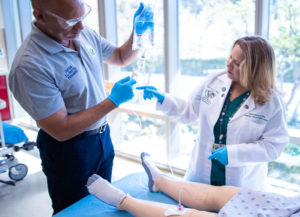
Gordon Center Offers Powerful Curriculum for Clinical Simulation Learners
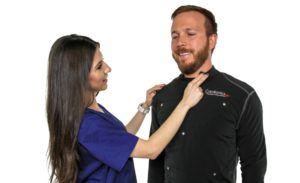
Bionic Hybrid Simulator from Cardionics Enables Auscultation Training on Low-Fi Manikins and Standardized Patients

Top 50 Clinical Simulation Posts of 2019!

7 More Healthcare Simulation Terms You Don’t Know!
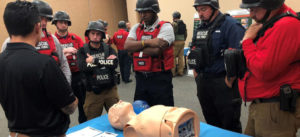
Key Updates From Michael S. Gordon Center for Simulation and Innovation in Medical Education

Recorded Webinar: Best Evidence Use of Auscultation Simulation in Your Curriculum
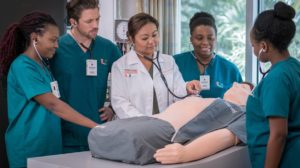
A Closer Look at Harvey: The Leading Cardiopulmonary Patient Simulator From the Gordon Center
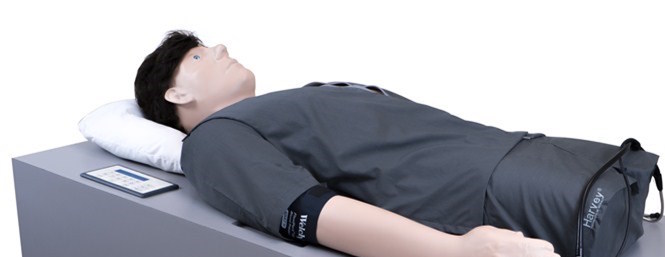
Next Generation Harvey Cardiopulmonary Simulator Now Available from From Gordon Center | IMSH 2017 Video Interview
Infant Heart Rate Audio Files Demonstrate Beats Per Minute (BPM)
Sponsored Content:



